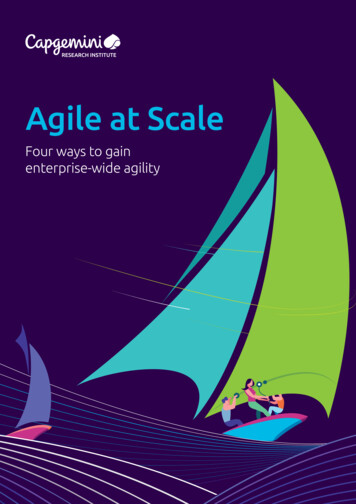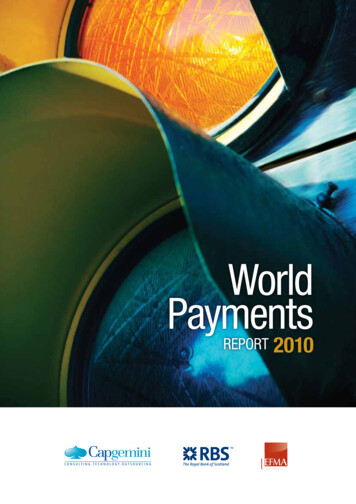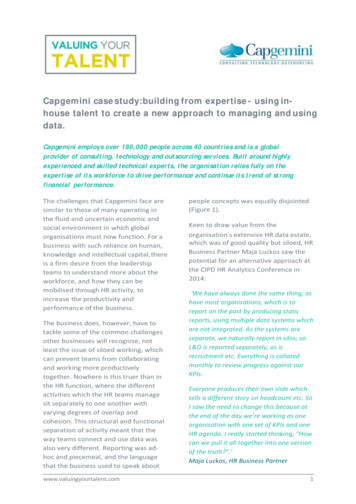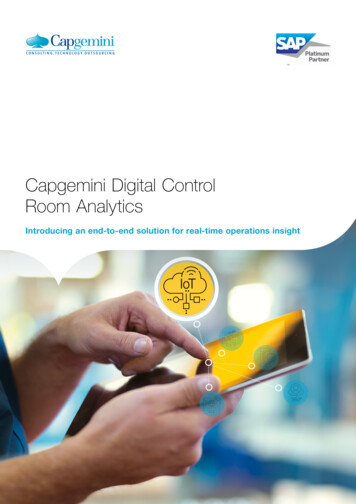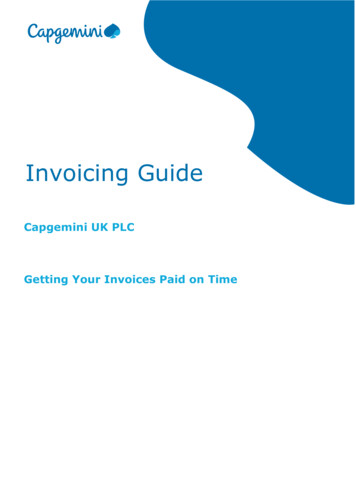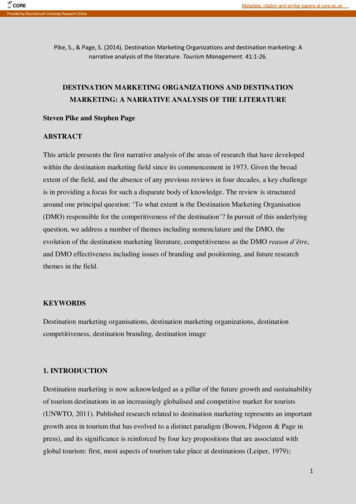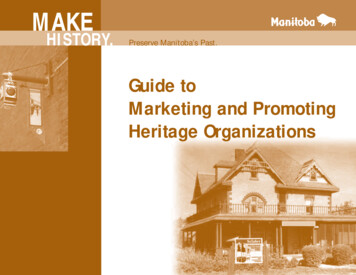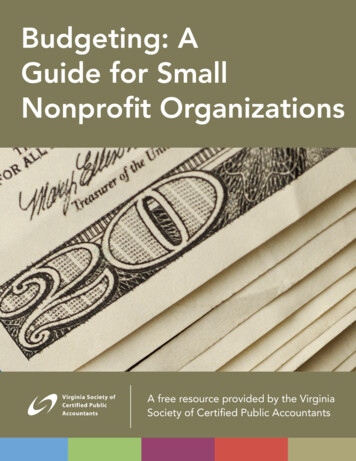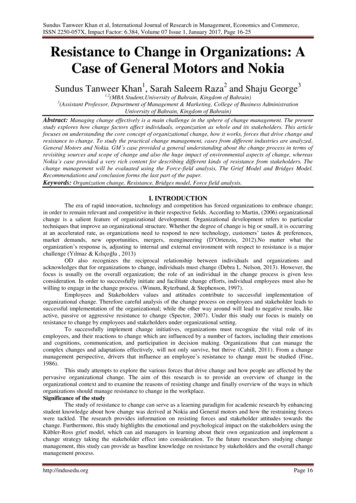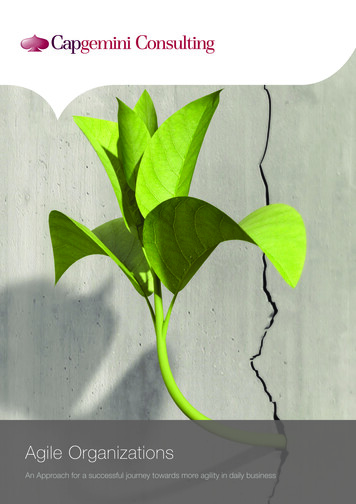
Transcription
Agile OrganizationsAn Approach for a successful journey towards more agility in daily business
2Agile Organizations
Content1. Management Summary52. Introduction63. What is Agile?74. Results of our survey94.1. Those who succeed in grasping and internalizing agileworking principles aim to go one step further.94.2. Innovation works best agilely. Yet the agile approach doesnot necessarily reflect the best in all matters.114.3. The approach towards an agile organization isuncharted territory for most enterprises.124.4. Additional findings145. How to become an Agile Organization175.1. Agile Continuum and Incubators175.2. Organizational Culture185.3. Leadership & Governance195.4. Organizational Structure & Processes205.5. Tools & Technology216. Conclusion237. Glossary248. Authors313
4Agile Organizations
1Management SummaryAgility as a business concept has beenused in IT and other development work forover 20 years, but the application of thismethodology has been largely limited tothe project world. Yet the implementationof an agile mindset and the associatedbenefits can unlock the major potential ofthe Agile Organization concept. This is adevelopment that is currently subject tomuch debate and discussion acrossdifferent industries and sectors. Agility is akey aspect of a healthy operating model1,which serves as an organizational blueprintand lays the foundation for the detaileddesign and implementation of a strategy.To enrich the debate, Capgemini Consultinghas conducted the “Agile OrganizationStudy 2017”. Of the insights gained, threekey findings stand out most notably:Those who succeed in grasping andinternalizing agile working principlesaim to go one step further.Business units that have had successfulexperiences with agile working methodstend to further intensify these methods.In IT-related units, for instance, 96% of therespondents indicated that they apply agileworking methods within projects and theday-to-day business. Moreover, our surveyreveals that agile advocates striving tofurther expand agile working methodsconstitute a disproportionately high quota.Within the middle and back office operations, approximately 48% have experiencein agile working, ranking second placefollowing IT, and similar to their ITcolleagues, plan to further pursue anagile transformation. In total, 83% of therespondents confirmed their goal to rollout agile working methods within theirenterprises (Figure 1).Figure 1: Any plans for further transformation towards Agile?The approach towards an AgileOrganization is unchartered territoryfor most enterprises17%83%Yesthese sectors, it will be necessary tobalance both tension and correlatedimplementation difficulties between agileand traditional working methods.Not yet planned Capgemini Consulting 2017Innovation works best agilely. Yet theagile way does not necessarily represent the best approach in all matters.In general, agile working methods proveto be successful in innovation and whererapid progress frequently turns out to bethe better approach over perfectionism.Agile methods function best in departments strongly linked to direct and indirectmarket influences (e.g. marketing, sales,product development, R&D, etc.) as wellas project management cross-functions.In departments that focus primarily onthe identification, avoidance and prevention of errors and risks, agile workingmethods prove to be less successful andinitial experiences do not indicate progressin this direction. Finance/Risk/Compliance(FRC), accounting and controlling areexamples of such areas. If the AgileOrganization concept is to function inOur research shows a huge variation in theperception of the ultimate target state inAgile Organizations. In terms of agilemethods, success factors and prioritiesfor an Agile Organization, a concordantview has not yet been established.Due to this large variation and lack of available clarity, we have developed a consistent framework, including a transformationcharter, based on both our consultingexperience and the survey findings. Thisframework takes into account typicalimplementation failures we have observedin the market. Our transformation charteris composed of four dimensions: Organizational CultureLeadership & GovernanceOrganizational Structure & ProcessesTools & TechnologyThe framework also relies on the conceptof incubators. These serve as vehicles andenablers for each dimension’s agile transformation and guide the organization onits journey towards agility. This procedure avoids radical interventions andutilizes instead a gradual organizationaltransformation. As a result, short-termsuccess can be quickly achieved.1 Please refer to our Study „Agility & Congruency: The success formula of healthy Operating Models”5
2IntroductionAgile Organizations have been introducedby many proponents as the new norm toequip companies with the ability to rapidlyadapt to market and environmentalchanges in a productive and cost-efficientmanner. This need becomes even moreimperative as pressure from nimblercompetitors and more demandingconsumers increases.While the majority of the participants werelarge companies in the financial serviceand automotive sectors, important comparative data was also obtained fromother industries and smaller companies.Twelve countries, including China, the USA,and many European countries participatedin the survey, with the majority of participants coming from Germany.In this report, we take a close look at organizational agility, what it entails and how itcan be applied to companies in differentindustries. For this purpose, we have conducted the “Capgemini Consulting AgileOrganization Survey” with 119 participants from industries accross all businesssectors (Figure 2).Our survey results indicate that agilemethods are known to respondentsprimarily through their use in projects, yetmost respondents see significant benefitsin broadening their application scope todaily business processes.Based on the results of our study andexperience gained from various projects,we were able to refine and optimize ourtransformation model towards becominga more agile and customer-centric organization based on daily agile practices. Theremainder of this document lays out theprimary cornerstone concepts of thisapproach.Figure 2: Industries represented in the survey (%)Industries presented in the survey (%)Number of employees (%)52.1 % 10.0005%5.9%5.000 - 10.0008.4%16%1.000 - 5.0007.6%34.5%7.6%0 - 1008.4%15.1%100 - 1.0008.4%Revenue in Million 10.1%52.9% 1.000Financial ServicesAutomotiveConsumer Products & RetailEnergy & UtilitiesManufacturing, High TechTelecommunication, Media & EnterntainmentLife Sciences & Chemicals500 - 1.00012.6%50 - 25012.6%5012.6%250 - 5005%*excluding 4 % of participants not stating their revenue Capgemini Consulting 20176Agile Organizations
What is Agile?Progress in globalization and digitalizationhas shifted the work environment fromrelatively stable, transparent and predictable to more instable/ inflexible, non-transparent and unpredictable. Constant transformation and uncertainty are the newnorm, posing many new challenges tocompanies. The ability to quickly andflexibly respond to changing businessenvironments and stakeholder/customerexpectations – in other words, beingagile – is a decisive factor in determiningan organization’s competitiveness andlong-term survival.But what does agility actually imply? Mostpeople know the term agile as a projectmanagement method used in softwaredevelopment. However, agility can beconsidered in a far broader context, suchas the generalization of the principles ofthe Scrum concept and techniques todiversify business activities.Scrum is an example of an agile approachoriginated from agile software development. It assumes that software projectscannot be planned in detail prior to projectbegin due to the complexity of suchprojects. For this reason, planning isbased on the principle of step-by-steprefinement. This implies that companieshave the opportunity to react quickly andflexibly to changing environments and arenot bound to a static project.Other agile management tools includeKanban, DevOps, Scrumban, DesignThinking and iterative development. Theseare similar in nature as agile approachesand are focused on collaboration andimprovement of quality and processes.Companies can easily utilize theseapproaches individually or in combination.As in the case of Scrumban, a cross-optimization can be observed when toolsare used in combination. Scrumban is ahybrid approach, combining the Scrumand Kanban methodologies. Kanban isused for incremental process improvement, with a pull system smoothening theflow of a project. Kanban itself wasdeveloped as a flexible and decentralized production process control systemin which identification cards are assignedto each product, assembly and item usedin operations. Both approaches supporta company on the road to agility.At its core, the term “agile” refers to aniterative, incremental method of managingdesign and building activities with an aimof carrying out new products in a highlyflexible and interactive manner. In this case“product” might be any kind of deliverableof an agile team (i.e. software, customerproduct, process improvement, marketingcampaign, etc.). It requires capable individuals across different disciplines, openness to constant (customer) input and anon-hierarchical management form witha mindset that allows for failure.“Being agile means constantly being adaptiveto change. It constantlyraises the question whatwe can do better in orderto succeed.“3Ralph Kienzler, Head of „GroupAccounting“,Landesbank Baden WürttembergA milestone in the coining of the termagile was the publication of the “Manifestofor Agile Software Development (AgileManifesto)”2 in 2001, which brought toprint certain practices that had alreadybeen used in software development formore than a decade. It also has conceptual links to lean techniques includingKaizen and Six Sigma. These principlesare management and business strategieswhich are used by companies for continuous improvement and effective processeswhile avoiding errors and risks and achieving greater benefits for the company as awhole.The Agile Manifesto is centered onfour values: Interaction and individuals are moreimportant than standard proceduresand tools. Delivering a working product is moreimportant than extensive documentation. Fostering more customer collaborationover relying mainly on contractnegotiations. Being open to changes instead ofneedlessly clinging to your initialproject plan.Applying these values or principles on anorganizational level provides an indicationof how an Agile Organization is going tolook.To dismiss the term “Agile Organization”as just another fashionable term, would bea mistake. It neither refers to just simplybeing a nimble organization nor does itencompass a static process framework.Rather, an Agile Organization represents achange in mindset that enables an organization to react more quickly to externalforces, while at the same time fostering2 http://agilemanifesto.org/7
resilience, responsiveness and learningfrom within. Additionally, agility meansto constantly assess the status quo andto adapt to changes instantly in order tosucceed on the road of transforming toorganizational agility.This ability to learn and improve quickly isa major differentiator of (most) start-ups incomparison to larger and/or establishedcompanies. Start-ups tend to focus oncustomer needs instead of being heldback by hefty internal processes. Thus,being agile means retaining the start-upmindset, even in larger organizations.““Agility is a company’sability to sense and respondto change adequately andin due time.4Figure 3: Case Study Adidas3adidasSteps conducted Employees select theirobjectives and focusesOutside-In-PerspectiveExchange of information oninternal and external levelSelf-directed learninglarge variety of differentcoursesConstant reflection of usedmethods, contents and ownattitudesThere is currently no generally accepteddefinition for the term “Agile Organization”.For this reason, Capgemini has launchedthe Capgemini Consulting Agile Organization Study 2017. The results provide uswith an added factual basis, which wecan utilize in helping our customers ontheir journey towards becoming an AgileOrganization.3 ur-agilitaet.pdf4 Please refer to our Study „Agility & Congruency: The success formula of healthy Operating Models”8Agile OrganizationsSector: SportswearCountry: GermanyEE: 60.000Revenue: 17 bn. Impact Higher employeesatisfactionEnsuring development ofmarket oriented productsFaster decision making andproduct development Capgemini Consulting 2017
4Results of our surveyOverall, the results of our survey show ahigh potential and motivation for a (further)roll-out of agile working methods. Thesurvey results also indicate the businessunits in which agile working could beapplied best and the units in which agileworking shows a rather low potential.Finally, it becomes clear that the approachtowards becoming an Agile Organizationis still fairly unknown. This is consistentwith another study performed byCapgemini Consulting, which addressesthe strategic organizational changes thatneed to be made to an organization’soperating model in order to implementagility on a long-term basis.Those who succeed in grasping andinternalizing agile working principlesaim to go one step further.Figure 4 contrasts the experiences in agileworking as well as plans and intentions fora further roll-out of agile-related workingmethods. As many as 83% of the partici-pants strive to further expand agilemethods within the corporation, and 54%of this group has already had positiveexperiences with agile working. However,29% have no current experience in agileworking but strive to transform into anAgile Organization. For those with experience with agile approaches, 85% decidedto continue utilizing the agile
08.05.2017 · Organizational Culture 18 5.3. Leadership & Governance 19 5.4. Organizational Structure & Processes 20 5.5. Tools & Technology 21 6. Conclusion 23 7. Glossary 24 8. Authors 31 Content 3. 4 Agile Organizations. 1 Management Summary 1 Please refer to our Study „Agility & Congruency: The success formula of healthy Operating Models” 5 Agility as a business concept has been used in IT
